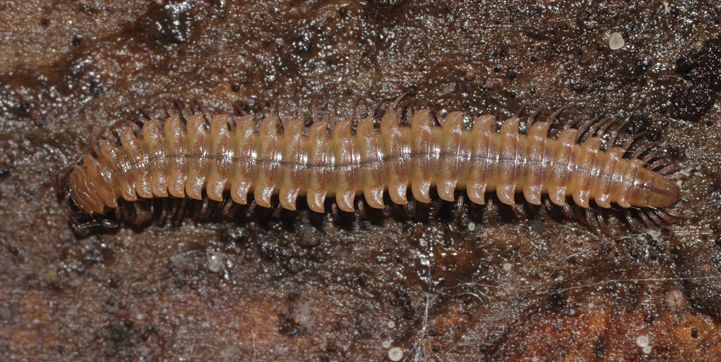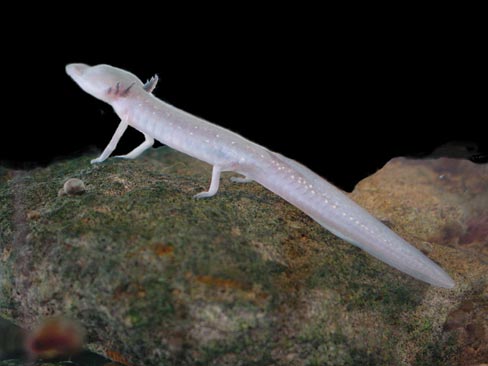|
Lipseuma
''Lipseuma'' is a genus of Millipede, millipedes in the Family (biology), family Kashmireumatidae. This genus contains only two species, the type species ''Lipseuma josianae, L. josianae'' and its close relative ''Lipseuma bernardi, L. bernardi''. Both species are List of troglobites, troglobites found in caves in China. Discovery This genus and its two species were first described in 2006 by the biologist Sergei Golovatch of the Russian Academy of Sciences and two biologists at the National Museum of Natural History, France, Muséum National d’Histoire Naturelle in France, Jean-Jacques Geoffroy and Jean-Paul Mauriès. The original descriptions are based on specimens collected in 1999 by the Biospeleology, biospeleologists Josiane and Bernard Lips, for whom the genus and its two species are named. The ''L. josianae'' holotype (a male) and seven Paratype, paratypes (two males, one female, and four juveniles) were found in the Chuan Dong Zi cave in Banqiao in Hubei province in Ch ... [...More Info...] [...Related Items...] OR: [Wikipedia] [Google] [Baidu] |
Lipseuma Josianae
''Lipseuma'' is a genus of millipedes in the family Kashmireumatidae. This genus contains only two species, the type species '' L. josianae'' and its close relative '' L. bernardi''. Both species are troglobites found in caves in China. Discovery This genus and its two species were first described in 2006 by the biologist Sergei Golovatch of the Russian Academy of Sciences and two biologists at the Muséum National d’Histoire Naturelle in France, Jean-Jacques Geoffroy and Jean-Paul Mauriès. The original descriptions are based on specimens collected in 1999 by the biospeleologists Josiane and Bernard Lips, for whom the genus and its two species are named. The ''L. josianae'' holotype (a male) and seven paratypes (two males, one female, and four juveniles) were found in the Chuan Dong Zi cave in Banqiao in Hubei province in China. The ''L. bernardi'' holotype (a male) and two paratypes (one incomplete male and one subadult male) were found in the Three Eyes cave in Xinlong coun ... [...More Info...] [...Related Items...] OR: [Wikipedia] [Google] [Baidu] |
Lipseuma Bernardi
''Lipseuma'' is a genus of millipedes in the family Kashmireumatidae. This genus contains only two species, the type species '' L. josianae'' and its close relative '' L. bernardi''. Both species are troglobites found in caves in China. Discovery This genus and its two species were first described in 2006 by the biologist Sergei Golovatch of the Russian Academy of Sciences and two biologists at the Muséum National d’Histoire Naturelle in France, Jean-Jacques Geoffroy and Jean-Paul Mauriès. The original descriptions are based on specimens collected in 1999 by the biospeleologists Josiane and Bernard Lips, for whom the genus and its two species are named. The ''L. josianae'' holotype (a male) and seven paratypes (two males, one female, and four juveniles) were found in the Chuan Dong Zi cave in Banqiao in Hubei province in China. The ''L. bernardi'' holotype (a male) and two paratypes (one incomplete male and one subadult male) were found in the Three Eyes cave in Xinlong coun ... [...More Info...] [...Related Items...] OR: [Wikipedia] [Google] [Baidu] |
Kashmireumatidae
Kashmireumatidae is a small family of millipedes belonging to the order Chordeumatida. These millipedes range from 5 mm to 14 mm in length and are found in East Asia. Adult millipedes in this family have only 26 or 28 segments (counting the collum as the first segment and the telson as the last) rather than the 30 segments usually found in this order. In the species ''Vieteuma topali'', adults have 26 segments, whereas in all other species in this family, adults have 28 segments. In some species (the genus ''Kashmireuma'' and the species ''V. longi''), the second leg pair in the adult female is vestigial, but in all other species in this family (the genus ''Lipseuma'' and the species ''V. topali'' and ''V. hubeiensis''), the adult female has a normal leg pair instead. Thus, in the genus ''Lipseuma'', the adult female has 46 pairs of walking legs, as one would normally expect in an adult female chordeumatidan with 28 segments (two fewer segments than typically found in thi ... [...More Info...] [...Related Items...] OR: [Wikipedia] [Google] [Baidu] |
Chordeumatida
Chordeumatida (from the Greek word for "sausage") is a large order of millipedes containing some 1200 species with a nearly worldwide distribution. Also known as "sausage millipedes," they possess around 30 body segments behind the head (including the telson) as adults and reach about in length. Description Chordeumatidans are relatively short-bodied, with only 26 to 32 body segments (including the telson) behind the head. They range in length from . A key feature is the presence of 6 large bristles (setae) on the dorsal surface of each body segment. The first segment ( collum) is relatively narrow, giving the appearance of a distinct "neck" in many species. The body tapers towards the rear, and the rearmost tip (telson) contains silk-producing organs (spinnerets). A dorsal groove runs down the length of the body, and some species possess paranota, lateral extensions of the exoskeleton. Paranota are also found in some other millipedes, notably Polydesmida, from which Chordeumat ... [...More Info...] [...Related Items...] OR: [Wikipedia] [Google] [Baidu] |
Genus
Genus ( plural genera ) is a taxonomic rank used in the biological classification of extant taxon, living and fossil organisms as well as Virus classification#ICTV classification, viruses. In the hierarchy of biological classification, genus comes above species and below family (taxonomy), family. In binomial nomenclature, the genus name forms the first part of the binomial species name for each species within the genus. :E.g. ''Panthera leo'' (lion) and ''Panthera onca'' (jaguar) are two species within the genus ''Panthera''. ''Panthera'' is a genus within the family Felidae. The composition of a genus is determined by taxonomy (biology), taxonomists. The standards for genus classification are not strictly codified, so different authorities often produce different classifications for genera. There are some general practices used, however, including the idea that a newly defined genus should fulfill these three criteria to be descriptively useful: # monophyly – all descendants ... [...More Info...] [...Related Items...] OR: [Wikipedia] [Google] [Baidu] |
Hubei
Hubei (; ; alternately Hupeh) is a landlocked province of the People's Republic of China, and is part of the Central China region. The name of the province means "north of the lake", referring to its position north of Dongting Lake. The provincial capital, Wuhan, serves as a major transportation hub and the political, cultural, and economic hub of central China. Hubei's name is officially abbreviated to "" (), an ancient name associated with the eastern part of the province since the State of E of the Western Zhou dynasty of –771 BCE; a popular name for Hubei is "" () (suggested by that of the powerful State of Chu, which existed in the area during the Eastern Zhou dynasty of 770 – 256 BCE). Hubei borders the provinces of Henan to the north, Anhui to the east, Jiangxi to the southeast, Hunan to the south, Chongqing to the west, and Shaanxi to the northwest. The high-profile Three Gorges Dam is located at Yichang, in the west of the province. Hubei is the 7th-largest p ... [...More Info...] [...Related Items...] OR: [Wikipedia] [Google] [Baidu] |
Gonopod
Gonopods are specialized appendages of various arthropods used in reproduction or egg-laying. In males, they facilitate the transfer of sperm from male to female during mating, and thus are a type of intromittent organ. In crustaceans and millipedes, gonopods are modified walking or swimming legs. Gonopods may be highly decorated with elaborate structures which may play roles in sperm competition, and can be used to differentiate and identify closely related species. Gonopods generally occur in one or more pairs, as opposed to the single (un-paired) reproductive organs such as the aedeagus of insects or the Opiliones penis, penis of harvestmen. Insects In insects, gonopods are appendages of the genital segment that may be used in insemination, or that comprise the egg-laying apparatus. Crustaceans In male decapoda, decapod crustaceans, gonopods are modified swimming appendages (pleopods). The anterior two pair of pleopods in males are modified for sperm transferring, with dif ... [...More Info...] [...Related Items...] OR: [Wikipedia] [Google] [Baidu] |
Order (biology)
Order ( la, wikt:ordo#Latin, ordo) is one of the eight major hierarchical taxonomic ranks in Linnaean taxonomy. It is classified between Family_(biology), family and Class_(biology), class. In biological classification, the order is a taxonomic rank used in the classification of organisms and recognized by the nomenclature codes. An immediately higher rank, superorder, is sometimes added directly above order, with suborder directly beneath order. An order can also be defined as a group of related families. What does and does not belong to each order is determined by a taxonomist, as is whether a particular order should be recognized at all. Often there is no exact agreement, with different taxonomists each taking a different position. There are no hard rules that a taxonomist needs to follow in describing or recognizing an order. Some taxa are accepted almost universally, while others are recognized only rarely. The name of an order is usually written with a capital letter. Fo ... [...More Info...] [...Related Items...] OR: [Wikipedia] [Google] [Baidu] |
Telson
The telson () is the posterior-most division of the body of an arthropod. Depending on the definition, the telson is either considered to be the final segment of the arthropod body, or an additional division that is not a true segment on account of not arising in the embryo from teloblast areas as other segments. It never carries any appendages, but a forked "tail" called the caudal furca may be present. The shape and composition of the telson differs between arthropod groups. Crustaceans In lobsters, shrimp and other decapods, the telson, along with the uropods, forms the tail fan. This is used as a paddle in the caridoid escape reaction ("lobstering"), whereby an alarmed animal rapidly flexes its tail, causing it to dart backwards. Krill can reach speeds of over 60 cm per second by this means. The trigger time to optical stimulus is, in spite of the low temperatures, only 55 milliseconds. In the Isopoda and Tanaidacea (superorder Peracarida), the last abdominal b ... [...More Info...] [...Related Items...] OR: [Wikipedia] [Google] [Baidu] |
Troglomorphism
Troglomorphism is the morphological adaptation of an animal to living in the constant darkness of caves, characterised by features such as loss of pigment, reduced eyesight or blindness, and frequently with attenuated bodies and/or appendages. The terms troglobitic, stygobitic, stygofauna, troglofauna, and hypogean or hypogeic, are often used for cave-dwelling organisms. A 2012 study by a team from the National University of Singapore found that reductive changes in freshwater cave crabs evolved at the same rate as constructive changes. This shows that both selection and evolution have a role in advancing reductive changes (e.g smaller eyes) and constructive changes (e.g larger claws), making troglomorphic adaptations subject to strong factors that affect an organism's morphology. Troglomorphism occurs in molluscs, velvet worms, arachnids, myriapods, crustaceans, insects, fish, amphibians (notably cave salamanders) and reptiles. To date no mammals or birds have been found to live ... [...More Info...] [...Related Items...] OR: [Wikipedia] [Google] [Baidu] |


.jpg)



